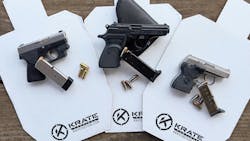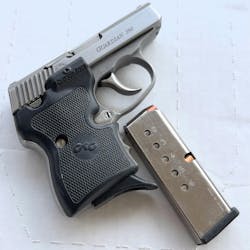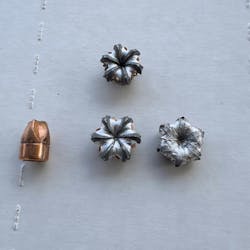Pocket Pistol Performance: A Look at the 380 Auto Cartridge
At one point in time, we were all dismissive about the .380 as a viable defensive cartridge. If you had asked me 15 years ago if the 380 was a good choice for a defensive cartridge, I would have said, “It is marginal.” It is still marginal in 2024, but the real question is, “Would you carry one?” I can answer this with, “Sometimes I do.”
The 380 Auto cartridge has been around for over 100 years. It was designed by John Moses Browning to respond to the need of a cartridge that had the great qualities of the 45 Auto, in a smaller package. The 380 was introduced in the US in 1908, and more readily adopted as a European service caliber during WWII. It had pretty extensive use as a police use and military service caliber in Europe up until the NATO standardization in the 1960’s.
The 380 enjoyed some popularity in the US. Handguns made for it are smaller and simpler than their 9mm counterparts. Recently, there has been somewhat of a surge in popularity in 380 handguns. One thing that this has caused is a real challenge for stores to keep 380 ammo on the shelves.
The utility of the 380 is a product of the original design intent of the cartridge, and the guns that surround this design. If we look at the actual dimensions of the cartridge, the 380 is almost exactly 78% of the dimensions of a 45 Auto cartridge. The purpose was to make an effective handgun/cartridge combination smaller, while retaining the quality of the parent cartridge.
Why is the 380 a 78% reduction of a 45? I believe it is because John Browning intended this cartridge to have the reliability characteristics of the 45. In my experience, 380s will fire in really dirty guns, and perform as advertised. This is not license for you to be derelict in gun cleaning duties, by the way.
Advantages of a 380
Because the 380 uses relatively low pressure to propel the bullet, at least in respect to the strong chambers and brass that surrounds the cartridge, it does not need a lot of gun to shoot it. Less gun means lighter weight and thinner structures. While 9mm guns need a locking mechanism like a tilting barrel to allow the chamber pressures to dissipate after the cartridge is fired, the 380 gun has a simple blowback system. Blowback guns use recoil spring pressure and the weight of the slide to contain the cartridge.
Because they generally don’t have tilting barrel mechanisms, 380 guns can have fixed barrels, and very simple trigger mechanisms. My Bersa 380, which is a DA/SA handgun has a recoil spring concentric with the fixed barrel. This is an 8+1, pocket sized gun. My North American Arms Guardian is even smaller, with an even simpler action. Both guns have a multiple strike capability. That is, in case of ammo failure, one needs only to pull the trigger again (without cycling the slide), a response that can be effective in many cases.
One of the smallest and most effective 380s on the market is a 380 that every Law Enforcement Officer should own: The Kahr P380. This is a 6+1 capacity gun that fits in the palm of the average sized hand. It has a 2.53” barrel and OAL of 4.9”. Whereas many 380 firearms weigh 15-20oz, the P380 weighs 9.9 oz. That’s right, there are bigger and heavier smart phones.
The Kahr P380 is one of my favorite pocket guns to shoot. The 380 cartridge is more challenging with a lighter gun, but I can rapid fire the P380 with little effort.
Most users purchase mid-sized 380s, not because they are easy to handle, but because they are less expensive. The Smith & Wesson Bodyguard 380 is only slightly larger than the Kahr P380 weighs 11.9 ounces. At an MSRP of $399, it is $300 cheaper than the Kahr.
One of the advantages of the 380 often overlooked is the inherent accuracy. Yes, accuracy. When all other factors are equal, the 380 will shoot well. This is not well known, simply because most guns built for it are not built for target shooting. The other part of this is the fact that most people can shoot 380 guns pretty well.
When we measure recoil impulse, the 380 can feel like a little more than half of a 9mm. It’s not just that, though. Most small 380s have small grips and simple controls. They are handy, and unintimidating.
Disadvantages of a 380
Although 380 guns are tiny, many manufacturers have become adept at miniaturizing 9mm guns, which are markedly more effective. For example, Kahr’s PM9 is a 9mm that is only slightly larger than the P380, and it weighs 14 oz.
Besides using a cartridge which is much more effective, many users can get their whole hand on the gun. For the most part, they are thinner. However, many micro guns do not accommodate the smallest finger. Some use a finger hook on the bottom of the magazine, which sort of defeats the purpose. Sometimes it is better to opt for a bigger gun which shoots better.
The 380 cartridge is considered marginal in the world of defensive handguns. When we evaluate cartridges, we generally use the FBI protocol, which requires penetration in bare gelatin between 12-18”. On the average, most 380 cartridges achieve 8-10”. There are exceptions. For example, many users prefer FMJ (full metal jacket) cartridges, which sometimes even over penetrate.
Actual cases suggest that the 380 maybe subject to the wrong metric. 10” of penetration is effective when the shot is accurate, and the intended target is not at an oblique angle. Overpenetration is very undesirable, and can even be reckless. It is much better to seek a cartridge that can inflict effective tissue damage within the limited wound channel.
I fired three 380 cartridges into ballistic gelatin: Winchester Defender 95 grain, SIG Sauer 90 grain V-Crown, and Black Hills Ammunition 60 grain Honey Badger. Both the SIG Sauer and Winchester bullets came to rest just shy of 10”. Both of them had 140% expansion, and the evidence of the wound channel points toward rapid expansion. The Honey Badger is a monolithic solid, and it was not designed to expand. It went the furthest in the ballistic gelatin, and the wound channel disruption was dramatic. It is also the lightest bullet in the lineup.
Although the cartridges listed here are do not regularly make the 12” minimum penetration in the FBI protocol, they are some of the best performers in 380 Auto. Just so you know, all three cartridges do not make 12 inches regularly, but occasionally they do. As long as the user recognizes the limitations of the cartridge, they can be used intelligently for their intended purpose. I do test them through clothing media also, since shirtless assailants are rare. For the most part, 380 performance is similar through clothing tests, and never very reassuring through any type of barrier.
Make the 380 more effective
There are three simple rules of cartridge effectiveness in the firearms industry, otherwise known as Lindsey’s Rules:
- Shot placement
- Shot placement
- Shot placement
With these rules in mind, I would pick a 380 that is reliable, easy to shoot (one that I can shoot well), and concealable, in that order. When I assist people in purchasing firearms, I always tell them that I have to be able to do a hostage rescue shot, with no warm up, at 7 yards. That is, I have to be able to put all of my shots within a 4” circle at 7 yards.
With a 380, this ability becomes even more critical. Generally, I train shooters on the range to shoot a controlled pair of shots at center mass, then line up a head shot. In a defensive situation with a 380, when there is a clear pathway to the head shot, take it.
Practice
To practice this, begin at “low ready”, using the standard qualification target for your agency. From 7 yards, you’ll be engaging this target at 7 yards. Use a shot timer to start you. From low ready, fire a single head shot within 3 seconds. Once you become proficient here, begin this challenge from concealed carry.
You may need to begin at 5 seconds, and work your way down to 2 seconds. Some shooters can do this drill in 1.5 seconds. This drill is designed for IWB or OWB carry only. If your method of carry is pocket carry, add one second, and include a clearing strike to your draw. If your method of carry is some sort of off-body device, like a backpack, discard this device and re-assess your carry options. I am certain that I just offended half of the industry, but my mission is to increase the reader’s survivability, and honesty is one of the requisite tools.
When I do this drill, I generally use my Bersa Thunder. I can shoot head shots with my Bersa at 7 yards all day long, any day of the week. I can do the same with the Kahr P380, but I can last all day shooting the Bersa.
The bottom line
A pocket sized 380 is a good thing to have. I have seen its effectiveness in actual shootings, and it is an excellent tool in the correct hands. Many users shop for high capacity 9mm guns, then realize that the thin single-stack 380s are tiny, and simple. The 380 is a good summertime gun for running shorts and tank tops.
About the Author

Officer Lindsey Bertomen (ret.), Contributing Editor
Lindsey Bertomen is a retired police officer and retired military small arms trainer. He teaches criminal justice at Hartnell College in Salinas, California, where serves as a POST administrator and firearms instructor. He also teaches civilian firearms classes, enjoys fly fishing, martial arts, and mountain biking. His articles have appeared in print and online for over two decades.


